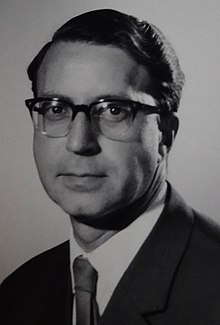Joachim-Ernst Meyer
Joachim-Ernst Meyer (born July 2, 1917 in Königsberg , † June 7, 1998 in Göttingen ) was a German psychiatrist .
Life
family
JE Meyer came from a family of psychiatrists. As the son of Ernst Meyer , he grew up with three siblings on the grounds of the mental hospital in Königsberg (his older brother Hans-Hermann Meyer later became director of the university mental hospital in Homburg / Saar). His grandfather Ludwig Meyer , whose commitment to the mentally ill (not least through the abolition of coercive measures) impressed him early on, had shaped him particularly on his professional path.
JE Meyer married Ruth Thwaites (* Johannesburg , South Africa) in 1953 . They had two daughters.
Career
After JE Meyer had completed his medical studies with a doctorate in Berlin in 1940, he worked as an assistant at the neuropathological department (with Willibald Scholz ) of the Max Planck Institute for Psychiatry in Munich as well as at the neurological clinic (with Kurt Behringer) and the clinical department Physiology (with Richard Jung ) at the University of Freiburg . Here he completed his habilitation in psychiatry and neurology in 1953. This was followed by a study visit of several months at the Research Center for Psychopathology at the Crichton Royal Hospital in Dumfries (Scotland) with Wilhelm Mayer-Gross . From 1954 JE Meyer worked as a senior physician at the mental hospital of the University of Munich (with Kurt Kolle ) and took over the management of the psychiatric university clinic in Göttingen from 1963 until his retirement in 1985. In 1965 he was appointed dean of the medical faculty and in 1968 rector of Göttingen University . In 1983 he received an honorary doctorate from the Medical Faculty of the University of Münster and in 1985 an honorary membership of the German Psychoanalytic Society (DPG).
Act
During his time in Scotland, JE Meyer got to know the work of Gertrud Heller (movement work according to Elsa Gindler ) in the progressive Crichton Royal Hospital . With the suggestion to invite her to courses in Freiburg and Munich in 1953, he made a decisive contribution to the development of concentrative movement therapy (KBT) (founded by the psychotherapist Helmuth Stolze ). In general, it was very important to JE Meyer to bring psychiatry and psychotherapy together.
The psychiatric clinic in Göttingen, whose management he took over in 1963, was one of the first to implement the institutional separation of the previously interlinked subjects of psychiatry and neurology. JE Meyer recognized the danger associated with this, but also saw the advantages that the professional independence of psychiatry brought with it.
A joint training center emerged from the close personal friendship with Werner Schwidder and the cooperation with the senior doctors of the Lower Saxony State Hospital in Tiefenbrunn . There, the assistants of the Psychiatric Clinic and the Institute for Psychoanalysis (today: Lou Andreas-Salomé Institute) connected to Tiefenbrunn were taught the basics of neuroses and clinical psychiatry and were able to exchange their different points of view.
The depth psychological expansion of his psychiatric field of vision did not lead to JE Meyer disregarding neurobiological aspects. It was important to him to maintain the balance between a scientific and a humanistic view of psychiatry. This balanced attitude is also expressed in the second and third editions of the manual “Psychiatry of the Present”, which he helped to shape.
The central impulse for the professional work of JE Meyer was his sense of social responsibility for the mentally ill. In many ways he tried to keep the public interested in the subject. As a member of the Bundestag Enquête Commission ( Psychiatrie Enquête ), he campaigned for the elimination of blatant social grievances and for fundamental improvements in the field of psychiatric health care. Especially in the last years of his life, he dealt intensively with psychiatry under National Socialism and warned emphatically against the dangers of a renewed discussion of euthanasia and against the practices of active euthanasia. During his rectorate in 1968, JE Meyer was open to the reform efforts of the time and was co-author of the publication “University Reform - Alternatives of Reason”.
Publications (selection)
- Concentrative relaxation exercises according to Elsa Gindler and their basics (1961) in: Helmuth Stolze (Hrsg.): The concentrative movement therapy . Springer Verlag, 1984.
- Society and its mentally ill . Vandenhoeck & Ruprecht, 1968.
- Death and neurosis . Vandenhoeck & Ruprecht, 1973.
- Fear of death and the death consciousness of the present . Springer Verlag, 1979.
- Psychiatry in the 20th Century: A Review . Goltze Göttingen, 1985.
literature
- Harald Feldmann : Personnel: Prof. Dr. med. Dr. hc Joachim-Ernst Meyer. In: Deutsches Ärzteblatt . Vol. 89, H. 28/29, July 13, 1992, pp. A1-2487 ( digitized ; for his 75th birthday).
- Hans Lauter : Joachim-Ernst Meyer July 2, 1917 to June 7, 1998. In: The neurologist . Vol. 70, 1999, H. 11, pp. 1034 f., Doi: 10.1007 / s001150050535 .
Web links
- Literature by and about Joachim-Ernst Meyer in the catalog of the German National Library
| personal data | |
|---|---|
| SURNAME | Meyer, Joachim-Ernst |
| BRIEF DESCRIPTION | German psychiatrist |
| DATE OF BIRTH | July 2, 1917 |
| PLACE OF BIRTH | Koenigsberg |
| DATE OF DEATH | June 7, 1998 |
| Place of death | Goettingen |
